Since its debut in 1977, Star Wars has become not only a cinematic phenomenon but also a rich tapestry of visual storytelling. Posters have played a crucial role in shaping how we experience and remember the saga. They’re not just promotional tools – they’re works of art, encapsulating characters, emotions, and galactic battles in a single frame. From hand-painted masterpieces to modern digital compositions, Star Wars posters have told stories of rebellion, destiny, and hope — and today, they’re just as likely to be part of unforgettable Star Wars-themed party decor as they are to hang in collectors’ galleries.. In this article, we rank the top 10 most iconic Star Wars posters, delving deep into their symbolism, artistic merits, and emotional impact on fans across generations.
1. Star Wars: A New Hope (1977) – Style A by Tom Jung

Arguably the most iconic Star Wars poster, Tom Jung’s Style A design captures the mythic tone of George Lucas’s space opera. Luke Skywalker, standing heroically with his lightsaber raised above his head, echoes classical heroic imagery. Princess Leia stands at his feet, blaster in hand, evoking strength and beauty. Darth Vader’s looming helmet dominates the background, representing the threat of the Empire. The twin moons and galactic backdrop hint at the scale of this universe. The balance of light and dark, hope and danger, is immediately apparent. This poster is rich in symbolism and sets the tone for the entire saga. It was a revolutionary piece of film marketing that drew audiences into a brand-new galaxy. The strong composition and romantic swashbuckling aesthetic made it timeless. Even decades later, it remains a favorite among fans and collectors alike.
2. The Empire Strikes Back (1980) – Style A by Roger Kastel
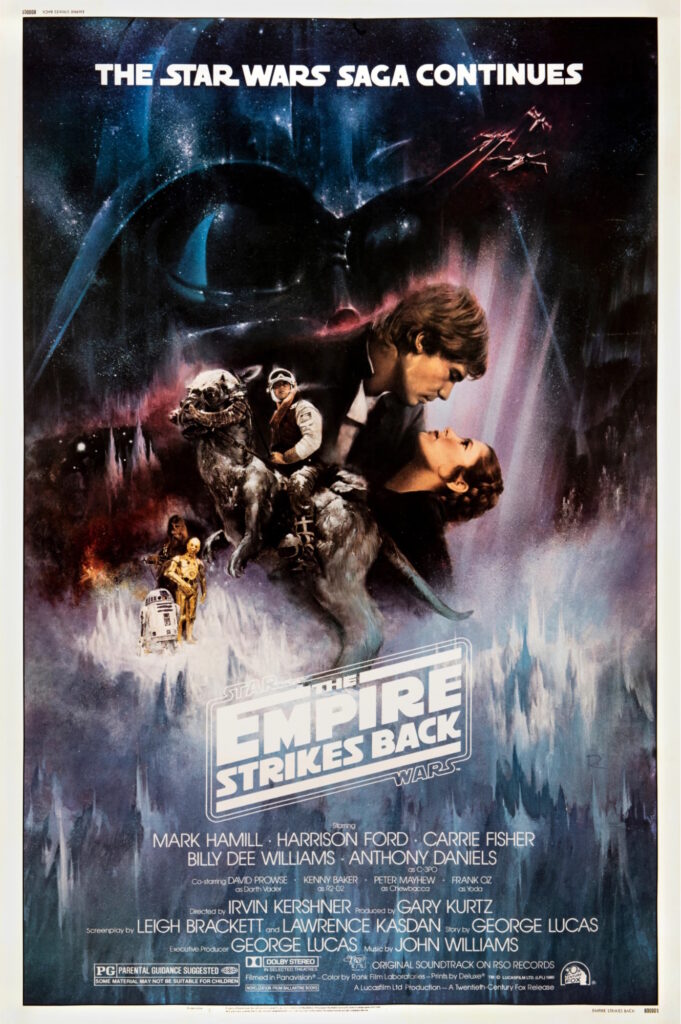
Roger Kastel’s poster is one of the most beloved in the franchise for good reason. It takes inspiration from the romanticism of the “Gone With the Wind” poster, placing Han and Leia in an embrace. Their pose adds emotional weight to their storyline, which becomes central to the film. Behind them looms Darth Vader, his mask casting a literal and figurative shadow over the characters. The dramatic mountain-like silhouette of the AT-AT walkers adds a sense of scale. Snowtroopers and Rebel soldiers in the lower section capture the epic scope of the Battle of Hoth. The colors are deep and evocative, creating an atmosphere of foreboding. This poster perfectly captures the darker, more mature tone of the second film. It suggests both romance and war, light and shadow. A cinematic and artistic masterpiece, it stands out in the series’ visual legacy.
3. Return of the Jedi (1983) – Style B by Kazuhiko Sano
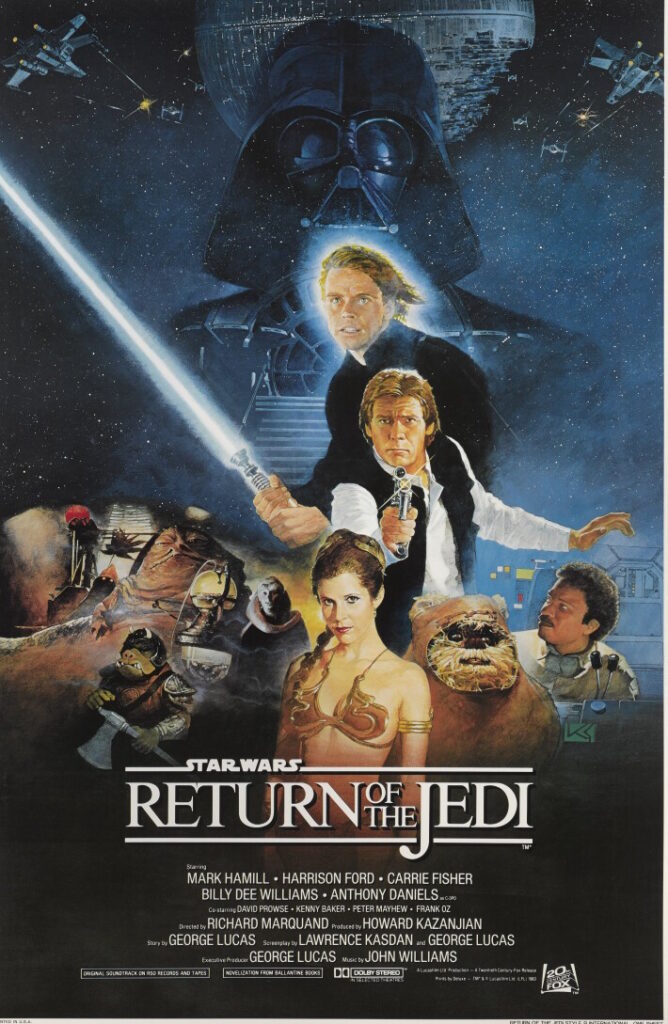
This poster is often praised for its beautiful arrangement and the emotion it conveys. It features Luke, lightsaber ignited, standing confidently in the center. Behind him, Darth Vader and the Emperor loom in ominous silhouettes. The Death Star and fleets of starfighters frame the conflict in cosmic scale. Han, Leia, Chewbacca, and the droids appear around the edges, reminding viewers of the ensemble journey. The poster’s brushstroke aesthetic gives it a painterly, epic feel. There’s a sense of closure and destiny that fits the trilogy’s conclusion. The bright green saber and red tones evoke themes of conflict and resolution. Kazuhiko Sano’s work invites viewers to relive the final battle between father and son. The balance between personal drama and galactic warfare is exquisitely portrayed. It stands among the finest examples of Star Wars poster art.
4. The Phantom Menace (1999) – Teaser by Drew Struzan

Perhaps the most effective teaser in film history, this poster is elegantly simple and powerful. A young Anakin Skywalker walks along the sand, but his shadow reveals the shape of Darth Vader. This chilling visual foreshadows his eventual fall to the dark side. The setting sun casts a golden hue, adding warmth and innocence. Yet the darkness in the shadow counterbalances that with dread. The power of this design is in what it doesn’t say. There are no spaceships or battles – just a child and his fate. Drew Struzan’s minimalist approach demands attention and sparks curiosity. It invites audiences to question destiny and identity. The teaser’s ability to stir emotions without overloading visuals is remarkable. This poster is haunting, elegant, and unforgettable.
5. Revenge of the Sith (2005) – Theatrical by Drew Struzan
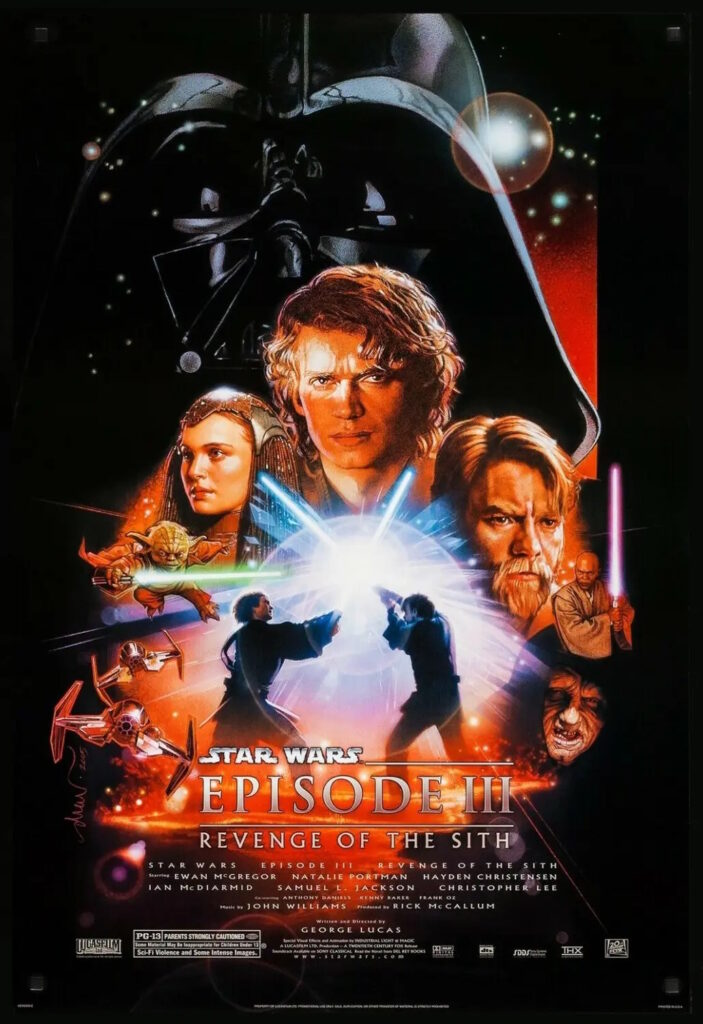
Struzan’s poster for Episode III is an emotional overload, and rightly so. It’s a collage of the film’s key conflicts and heartbreaks. Anakin and Obi-Wan are positioned mid-duel, saber clashes glowing. Padmé, Yoda, and Palpatine each represent a facet of Anakin’s life and choices. The flaming Mustafar background adds intensity and danger. Vader’s helmet fades in behind Anakin, symbolizing the looming transformation. The colors are saturated with red and gold, symbolizing tragedy and fire. This is a portrait of downfall, war, and the end of an era. Struzan’s painterly style adds weight and gravitas. Every character is painted with emotion in mind. The poster does not just preview a movie—it tells a story.
6. Attack of the Clones (2002) – Theatrical by Drew Struzan

This poster attempts to balance romance and war, just like the film itself. Anakin and Padmé take center stage, back-to-back, yet emotionally close. Around them swirl images of Yoda, Obi-Wan, and the Clone Army. The shading gives the impression of looming danger and political intrigue. The warm amber tones provide a sense of fading peace. There’s a suggestion of hidden turmoil beneath the surface. The poster also previews Anakin’s internal conflict, balancing duty and desire. The symmetrical layout is pleasing and classic. The gentle brushstrokes of Struzan add elegance to the chaos. It’s a visual overture to a complex chapter in the saga.
7. Rogue One (2016) – Theatrical Poster
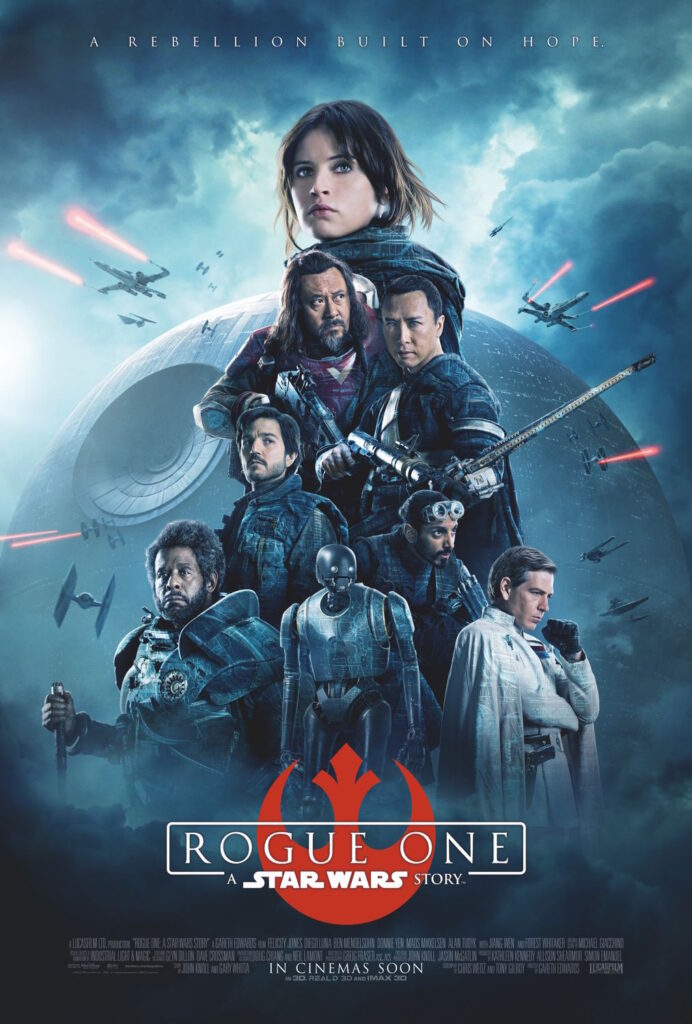
A gritty take on the Star Wars universe, this poster showcases a war film disguised as space fantasy. The looming Death Star above a tropical battlefield is a striking visual. The heroes are assembled in formation, their faces solemn and resolute. The choice of colors—cool blues and battlefield grays—adds urgency. Scarif’s palm trees and sci-fi elements juxtapose realism with myth. The circular composition subtly mimics the Death Star itself. It’s a visual metaphor for being trapped in a cycle of war. The ensemble cast, from Jyn Erso to K-2SO, is positioned with cinematic weight. The poster tells viewers this isn’t a story of chosen ones, but of sacrifice. It’s bold, mature, and visually rich. A modern classic in Star Wars marketing.
8. The Force Awakens (2015) – Theatrical Poster
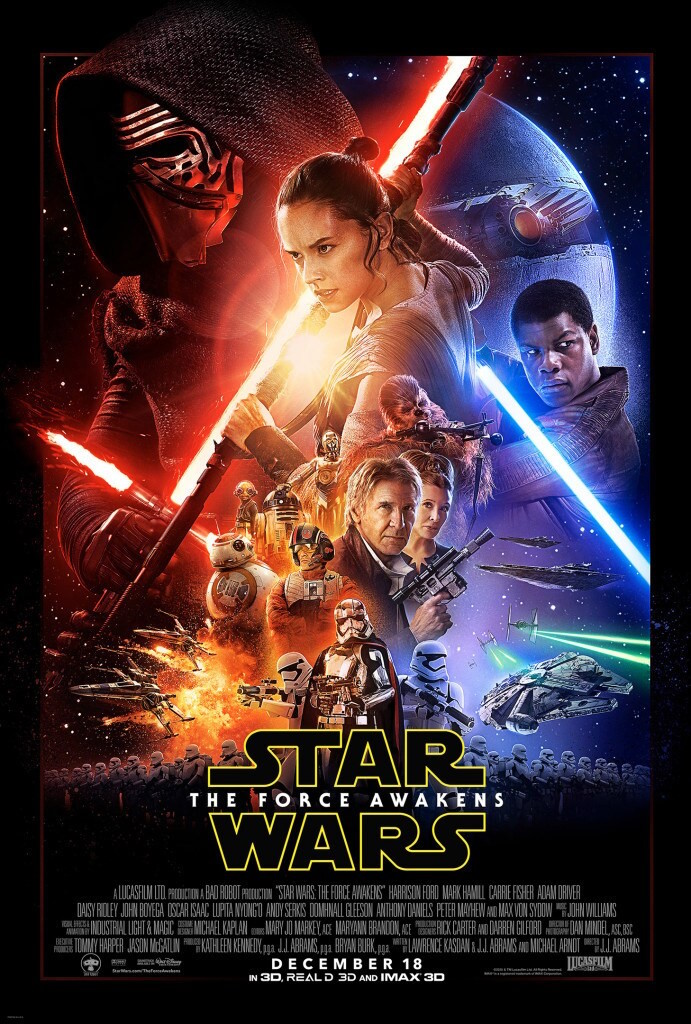
This poster had the monumental task of reviving the franchise, and it succeeded visually. It presents both legacy and newness with a perfectly symmetrical composition. Rey, the central figure, stands tall as the new beacon of hope. Kylo Ren mirrors her stance, saber raised in fiery red. The Millennium Falcon and TIE Fighters evoke nostalgia, while Finn and Poe add freshness. Han and Leia’s presence assures continuity. The use of vivid reds and oranges signals a galaxy in unrest. It visually bridges the old trilogy with new mythologies. The layout is pure Struzan inspiration, even though it was created digitally. It captures excitement, curiosity, and emotional resonance. Fans old and new were captivated instantly.
9. The Last Jedi (2017) – Teaser Poster
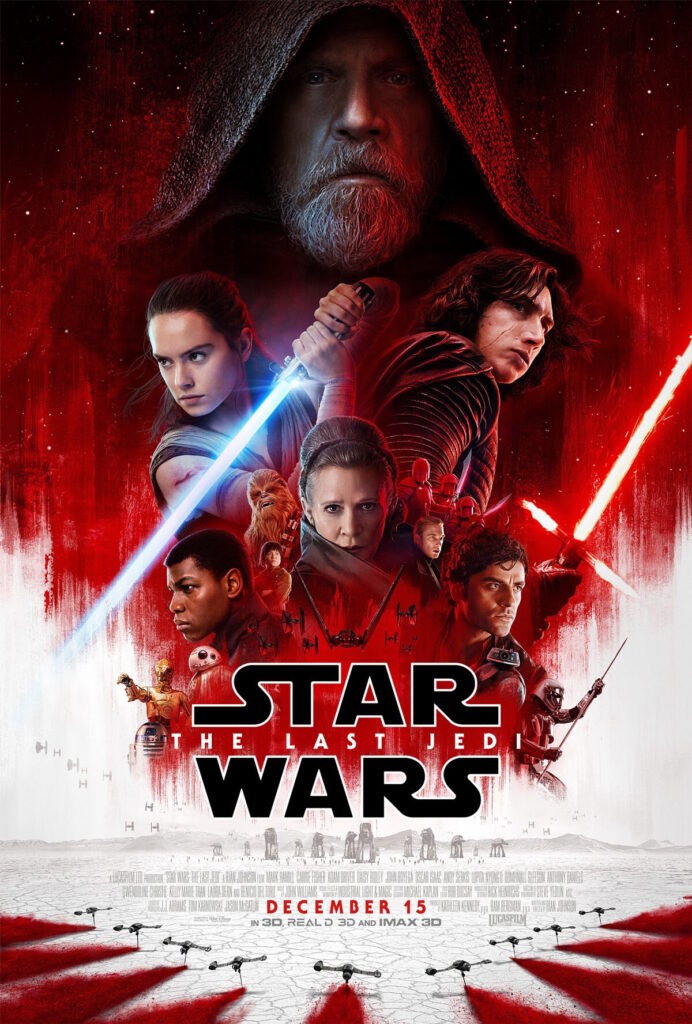
Striking in its simplicity, this poster features Rey lifting a lightsaber skyward. The blade forms a beam of light that splits the faces of Luke Skywalker and Kylo Ren. It’s a visual metaphor for Rey being caught between two legacies. The red tones dominate, signaling danger and radical shifts. The composition feels like a mythological painting. It’s sparse but loaded with meaning. Luke’s expression is haunted, while Kylo’s is volatile. The teaser does not overcrowd but leaves room for speculation. Its artistry lies in suggestion, not explanation. For fans, it was both thrilling and enigmatic.
10. Revenge of the Jedi (1982) – Teaser Poster by Drew Struzan
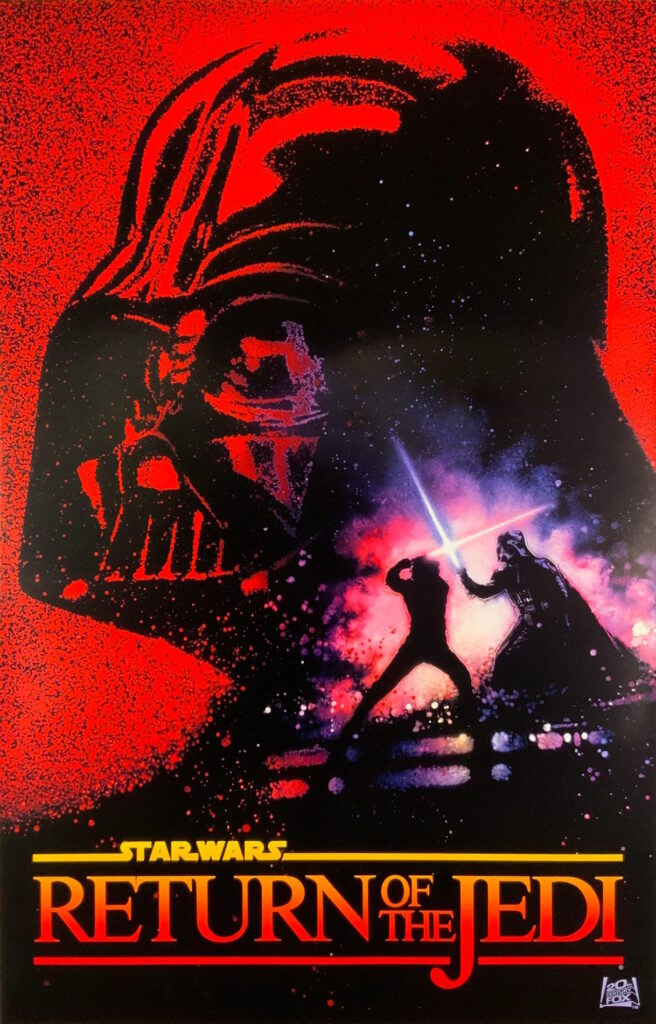
Before the title change to “Return,” this teaser hinted at a darker conclusion. The poster features red and black tones, with Vader and Luke dueling in silhouette. The color choice is more aggressive, less forgiving. “Revenge” in the title adds tension and raises questions. It suggests a more brutal ending to the saga. The lightsaber glow is fierce and the composition is tight. Fans immediately responded to its boldness. Though the title changed, this artwork remained a collector’s favorite. Struzan’s vision was raw, symbolic, and a glimpse into what might’ve been. It’s a legendary piece of Star Wars history.
Each poster in this list is more than just a piece of marketing – it’s a canvas for storytelling, emotion, and myth. The best Star Wars posters manage to do what the films themselves do: transport us to another world, inspire us with heroism, and confront us with the power of choice and destiny. Whether hand-painted by legendary artists or digitally composed in the modern era, these posters remain essential to the legacy of Star Wars. They are part of the reason why this galaxy continues to feel so real. And for fans, they are cherished not just as art – but as echoes of the Force itself.
